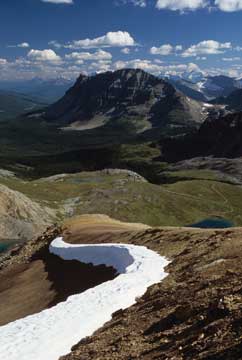|
NEWS NOTES
Geophysics
Earth’s heat buoys up its crust
 Derrick Hasterok |
| New research suggests that without the heat in Earth’s crust and upper mantle creating elevation, much of North America would be underwater. The Rockies, as pictured here in Canada’s Banff National Park, would still be well above sea level. |
Without the heat produced in and beneath Earth’s rocky crust, much of North America would sink below sea level, researchers have found. New York City would drown under 435 meters of water, New Orleans under 736 meters and Los Angeles under 1,145 meters of water. Even the country’s midsection would fall below sea level, except for the tallest ridges in the western mountain ranges. Differences in temperature in the crust and upper mantle between different regions of North America, they say, can explain roughly half of the elevation of any given location on the continent.
Generally, people think of tectonic forces, such as mountain-building plate collisions and basin-building continental stretching, as creating land elevation. But those tectonic forces act through the composition and temperature of the rock that they move, and thus the thickness, density and temperature of the crust all influence land elevation, wrote David Chapman, a geophysicist at the University of Utah in Salt Lake City, and Derrick Hasterok, a graduate student at the university, in the June 23 Journal of Geophysical Research. But how big a role temperature plays has not been well-defined, they say.
Pinpointing the effect of temperature in continental crust requires detailed analysis to remove the other effects, Chapman says. So he and Hasterok analyzed the rock under North America, adjusting for crustal densities and thicknesses to determine the impact that crustal temperature has on elevation.
Where crustal plates collide, mountains form, as exemplified by the Himalayas, which formed and continue to grow as the Indian Plate collides with the Eurasian Plate. The crustal plate collision also produces heat, making the rocks in the continental crust and upper mantle expand, becoming less dense and more buoyant, Chapman and Hasterok wrote. Furthermore, heat from any source, including from radioactive decay of uranium, thorium and potassium in the crust or from deep mantle processes, also causes the rock to expand and become more buoyant, they determined.
In this study, Chapman and Hasterok used seismic data to locate denser rock beneath the continent, by comparing the seismic results with known densities of various rocks to determine the crustal density at a location. Once they corrected for this variability in density, they then were able to determine just how much of an impact temperature has on elevation at any given location, they say.
On North America, Chapman and Hasterok wrote, if the crust beneath cities such as New York and Los Angeles were cooled to an average temperature of 400 degrees Celsius (about 750 degrees Fahrenheit) — the same temperature as some of the continent’s coldest crust — then these areas would sink. Their results show that heat alone accounts for about half of the elevation of most parts of North America, with rock type accounting for most of the other half. “I’m surprised,” Hasterok says. “You can write the equations and understand the effect, but you still don’t expect it.” Still, Chapman adds, people should not be alarmed by the numbers because it takes a billion years for continents to lose their heat.
By accounting for composition, thickness and temperature, Chapman and Hasterok think they can look for and try to explain anomalies in elevation and temperature as well. For example, with hotspots below Yellowstone, they can understand how the upwelling plumes of molten rock contribute to elevation.
Thorsten Becker, a geophysicist at the University of Southern California in Los Angeles, says the results were partially expected from similar analysis for oceanic plates. “While this study is a useful exercise,” he says, “the immediate conclusions for geodynamics are probably limited by the inherent uncertainties.” He says that a more detailed, region-by-region approach may provide more robust information for future studies.

 Subscribe
Subscribe


